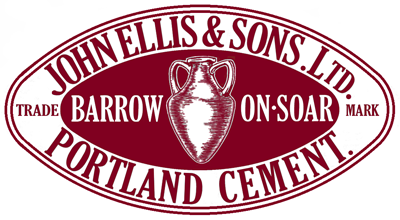
Ellis & Sons' Brand. The Barrow amphora was unearthed in a Roman cemetery in the village in 1867.
Location:
- Grid reference: SK58791669
- x=458795
- y=316690
- 52°44'41"N; 1°7'45"W
- Civil Parish: Barrow upon Soar, Leicestershire
Clinker manufacture operational: 1869-1935
Approximate total clinker production: 270,000 tonnes
Raw materials: Blue Lias Limestone (Blue Lias Formation, Barnstone Member: 197-200 Ma) by tramway from drift mine at 459600,316200 in Sileby parish. From the 1920s, Blue Lias limestone (Blue Lias Formation: 190-200 Ma) was brought by rail (40 km) from Kilby Bridge, Wigston Magna, (SP)461200,297200.
Ownership: John Ellis and Sons Ltd
Primarily a hydraulic lime plant, production of cement began in 1869 with perhaps two small dry process bottle kilns, output 30 t/week, although this product may not have been Portland cement in the strict sense. In 1883, Spackman installed kilns with his patent drying chambers, and proper Portland cement was certainly made. Stone from selected chemically-tested floors was finely dry-ground, then briquetted. There were six kilns, producing 120 t/week according to Davis, and this continued until closure. The product was used entirely on site in concrete products made with granite from the adjacent Mountsorrel quarry, and in the production of coloured “cement paint”. The original John Ellis was the major promoter of the Midland Railway, and he and his successors were directors: much use was made of it for raw materials and for shipping concrete products - notably paving slabs - into London. It's significant that cement production at Barrow commenced the year after the opening of St Pancras Station. Lime production continued until 1925, using six (but originally many more) bottle kilns. The Ketton company seems to have persuaded the company to cease manufacture. The concrete plant continued, using Ketton cement, after the kilns stopped, and was eventually bought out by Redlands. Their successors, Lafarge, still own the site, which is connected by a long conveyor to the Mountsorrel granite quarry, and ships the stone out by rail.
Power supply
No information
Rawmills
No information
No rotary kilns were installed.
Sources::
- Primary Sources:
- Spackman (anonymous references)
- local website
- Ordnance Survey 1:2500 mapping
- BGS mapping and monographs
- Confirmatory Sources: